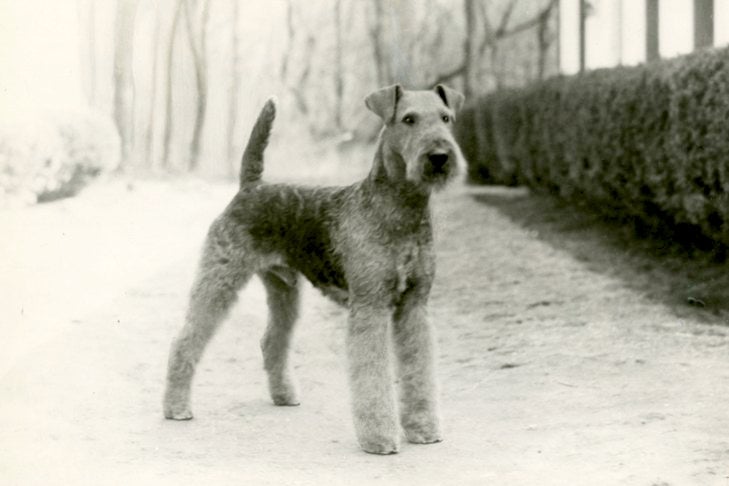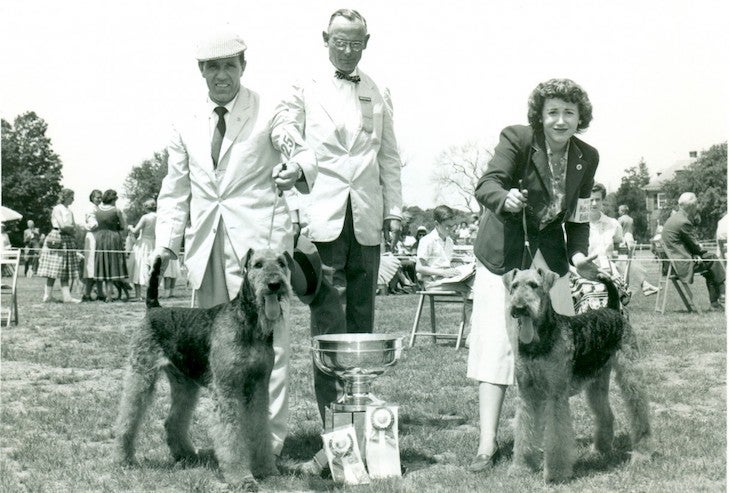
Heroism during wartime can propel an average Joe into the spotlight. Just ask the Airedale Terrier.
Called the “King of Terriers” because he is the largest in that family of earth dogs, the Airedale is believed to be the result of crossing various terriers with another British original, the Otterhound. That shaggy-haired hound contributed not just size and bone, but also a good nose and a fondness for water – important qualities for the rather amphibious Airedale, whose job description included hunting rats and otters in the streams and rivers of Yorkshire.
The Working Terrier
Like so many of the terriers, the Airedale was a working dog developed by working-class men who didn’t have the space or means to keep multiple dogs. As a result, the Airedale was intended to be a generalist, not a specialist: In addition to dispatching vermin, he could track and kill larger creatures, guard the family farm, retrieve everything from birds to rabbits, even drive home the occasional wayward cow. And while he was too big to go to ground like most other terriers, he had just as much spark and spirit as his smaller cousins.
This gritty versatility made the Airedale quite popular with poachers, who snuck on to sprawling Victorian estates to bag some of the plentiful game that was off-limits to commoners. (Failure didn’t just mean coming home empty-handed: An encounter with the patrolling gamekeeper and his Bullmastiff might result in not coming home at all.) On Saturdays, the dogs were frequently victorious in the river-rat hunts organized by the area’s factory and mill workers; the men would bet as much as a week’s wages on the dog they thought could locate a rat hole on the riverbank, wait for a ferret to flush it out, and then chase its occupant through the water until it closed its powerful jaws around the fleeing rodent.
Given these modest roots, the Airedale was not exhibited widely in dog shows throughout England in the late 19th Century. When he was entered at local Yorkshire shows, he was exhibited rather vaguely as a “Broken-Haired Terrier,” “Working Terrier” or “Waterside Terrier.” Wanting to give the breed a more specific moniker, one prominent breeder suggested the name Bingley Terrier, but that was rejected in order not to give undue credit to that eponymous Yorkshire town. Eventually, the name Airedale was adopted, a reference to the twisting Aire River and its valley, or dale, where this robust terrier was developed.

Military Dogs of World War I
The Airedale might have remained a little-known terrier of the Yorkshire countryside were it not for the arrival of the Great War. While the Airedale made a name for itself as the premier military dog in World War I as a sentry, messenger, explosives detector and search dog for wounded soldiers, his native Britain didn’t immediately appreciate his value in the trenches.
When the first Airedale was exported to Germany in the 1890s, that country was experimenting with the modern concept of a police dog. The Airedale fit right in: A handy size, he had a weather-resistant coat and excelled at tracking; in addition to being loyal and reliable, he was also courageous and protective when necessary. In 1900, the Germans used Airedales to patrol and carry messages and munitions during the Boxer Rebellion in China, with great success. By the time World War I dawned, the Airedale was a much valued military dog in Germany, alongside the homebred Doberman Pinscher, German Shepherd Dog and, in later years, Rottweiler.
There was, of course, a bitter irony in having such a quintessentially British breed considered the ultimate German Kriegshund, or war dog. As the war raged on, the British were quick to discover the amazingly versatile resource that was right under their noses.
In The Presence of the Enemy
In the waning years of the Victorian era, gentleman farmer Col. Edwin Richardson had become very interested how the ancient Greeks and Romans used war dogs, and in short order he was sought out internationally to provide dogs for that very purpose. He dispatched combinations of several different breeds – Airedales, Collies and Bloodhounds among them – to Russia during the Russo-Japanese war; to Turkey to help guard a sultan’s 700-woman harem, and to India to aid ethnic Nepali Gurkhas in maintaining British rule there.
In 1910, finally on his home soil, Richardson began the British War Dog School with Airedales and various breeds of sheepdogs. (Richardson knew that the Germans, in collecting stock for their military dogs, had come to Britain to purchase Collies, and used them with success.) But in short order it was obvious that the keen, harsh-coated terriers outshone them all. In the end, Richardson sent more than 2,000 dogs to the front, many of them Airedales.
There are numerous accounts of the tenacity and sheer pluck of these wartime Airedales, the most dramatic of which is the story of Jack. One of Richardson’s own, Jack ran a half-mile through a hail of mortars and gunfire. When he arrived at his destination, his jaw was shattered his job and his front leg maimed. Dutifully, he permitted a critical message to be removed from his collar – then fell dead on the spot. He was later awarded the Victoria Cross, the highest honor in the British military system, given for valor “in the presence of the enemy.”

From the Titanic to the Whitehouse
The exploits of Airedales like Jack immediately drew the public’s notice, and the breed’s popularity shot up accordingly. As is the case with so many breeds with working-class roots, the Airedale Terrier began to be noticed by those with the means and influence to promote them, among them socialite Mrs. John Jacob Astor, whose Airedale Kitty perished on the Titanic, as well as four United States presidents.
The breed is also associated with another prominent American who shared a similar up-from-your-bootstraps story, the noted black inventor and newspaper publisher Garrett Augustus Morgan. In addition to inventing the traffic light and the gas mask, Morgan developed the first chemical hair straightener, a “hair refining creme” that he first tested on his neighbor’s Airedale. (It worked so well the dog’s owner, not recognizing him, at first try to run him out of the house.)
President Warren Harding acquired Airedale, a six-month-old puppy named Laddie Boy, on the day after his inauguration in 1921. The terrier famously sat on his own hand-carved chair during cabinet meetings and received reams of press coverage, beginning the modern tradition of having the idiosyncrasies of the First Pooch covered relentlessly by the press, from his bone-cake birthday parties to his thoughtful fetching of Harding’s errant golf balls. For his part, the 29th president had a thousand miniature bronze statues of Laddie manufactured, and distributed them to his political supporters.
Some of those statuettes survive today, avidly sought by political-memorabilia collectors. As for the Airedale, he has weathered more than a century of existence with almost as little change as his diminutive bronze likenesses – something that can’t be said of quite a few breeds outside the very tradition-focused, fad-adverse Terrier Group. Baptized by the cold water of the River Aire, forged by the fire and smoke of the battlefield, the Airedale simply soldiers on.

